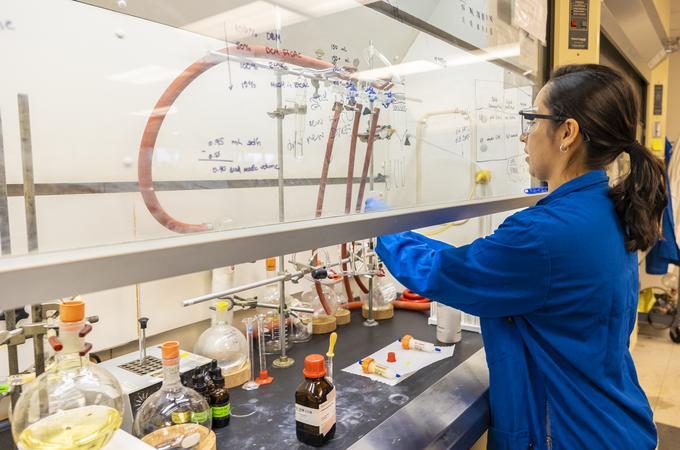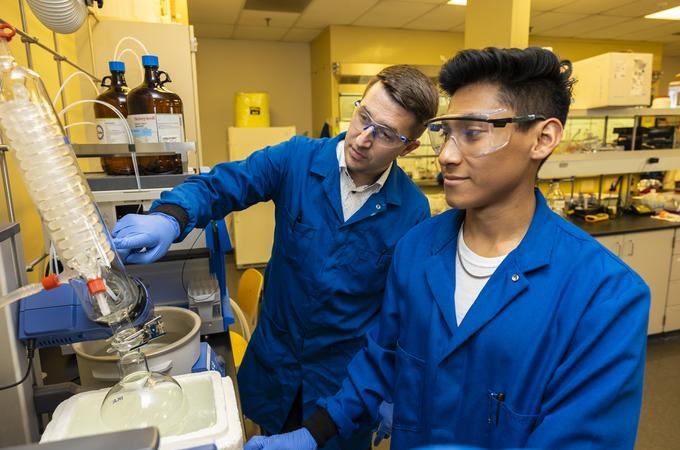Are there better alternatives to current opioids that can treat pain with fewer side effects? How can studying the structure of cyclic peptides advance our knowledge of opioids and pain treatment?
U of R student researchers, led by Chemistry Professor Michael Ferracane aim to answer these questions through an ongoing study. More than a dozen students have worked with Ferracane over the past seven years on collecting preliminary data and studying the structure, properties, and opioid activities of a series of related cyclic peptides, which are small segments of amino acids connected together into a cyclic structure.
Ferracane was awarded a National Science Foundation grant of nearly $250,000 to aid in the research for the next two years and provide financial support for chemicals, supplies, travel, and student stipends. It also helped fund new computer software that enables easier, quicker ways to interpret data and model the peptides, and a freeze drier, a machine that removes water and solvents from samples (a process that works the same as freeze driers to make astronaut ice cream and dried fruit). Other chemistry students also have access to the resources to gain first-hand experience working with research-grade equipment.

Three first-generation students – Alejandra Cordova ’24, Li Almazo Garcia ’24, and Daniel Plata ’24 – worked on the project through the Summer Science Research Program, and they are continuing their research during the academic year through their senior capstone projects.
Daniel, who is majoring in biochemistry and molecular biology with a minor in psychology, explained the research: “Our research focuses on the synthesis and characterization of opioid cyclic tetrapeptides, which have been shown to treat pain with reduced side effects in mouse models. We synthesize novel cyclic tetrapeptides via solid- and solution-phase synthesis. Once the linear precursor has been synthesized, we run a sample of it on two different instruments to check for the presence of the peptide and the purity of our product. From there we cyclize our peptide, purify it and after doing so, we have our final product.”
Ferracane notes that all the sample preparation and data collection is being done by the students. “As much as I can, I try to get students to be independent in designing, executing, and interpreting their experiments,” Ferracane said. “That’s one of the most rewarding parts about doing science, and I want them (the students) to have that experience whenever possible. There’s something gratifying about seeing something through from beginning to end.”
Once samples are collected and analyzed, the team will send the peptides off for testing at the National Institute of Mental Health, the University of Florida, and the University of California -Los Angeles. The team hopes to convey their findings through peer-reviewed research articles and presentations at local and national conferences. This summer, Alejandra, Daniel, and Li attended the American Peptide Symposium in Scottsdale, Arizona to present a poster on their research. They also heard presentations from leaders in the peptide field and spoke to researchers from around the world.
Alejandra was also awarded a fellowship from the ACS Division of Organic Chemistry Summer Undergraduate Research Fund that helped pay for her summer research. This fall, she traveled to Genentech in San Francisco to present her research to her peers and representatives from the industry. Alejandra believes, “participating in research does not only give me valuable experience but also will help me when applying for graduate schools, since a lot of schools look for students with research experience.”

Li wants to pursue a dual MD-PhD degree focusing on medicinal chemistry after she graduates. She believes this research has helped her gain a better understanding of medicinal chemistry and recognize a desire to continue a career in research. As a first-generation student, Li believes “I feel more committed because I don’t have people I could turn to at home regarding university. So, it’s taught me to put myself out there and ask my professors, upperclassmen, and friends for help.”
Daniel, who wants to pursue an MD, said “I chose Redlands because I wanted to attend a smaller school with a small student population; I wanted professors to know me and to not think of me as just another face in the crowd. With the smaller class sizes, it is much easier to have professors know your strengths and weaknesses in the classroom and can help work with you to succeed.”
Ferracane believes, “At Redlands, students that work directly with faculty receive significant attention from someone who is a disciplinary expert and is invested in their education and development. There’s a lot more to being a chemist than mixing chemicals together, and we have the knowledge and passion to help students develop the necessary skills and realize their potential. There are few environments that offer anything similar.”
To learn more about the Student Science Research program, click this link.
To learn more about the Chemistry Department, click this link.






